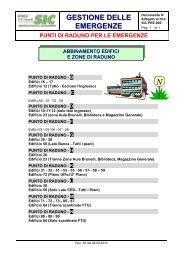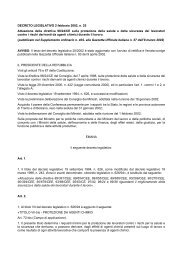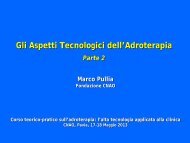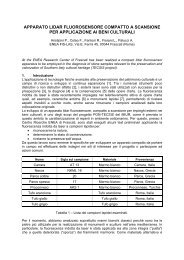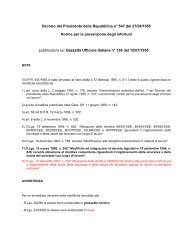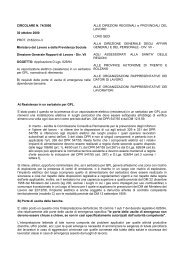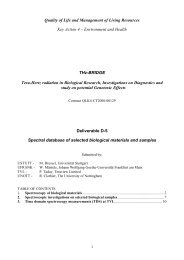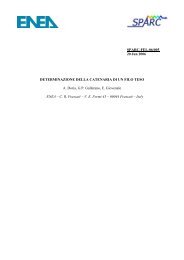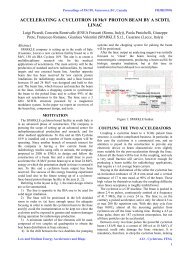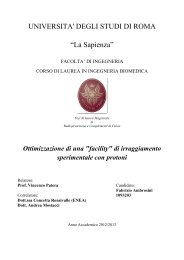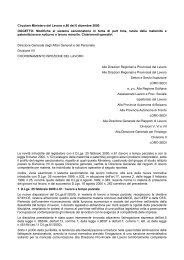Theory, Design and Tests on a Prototype Module of a Compact ...
Theory, Design and Tests on a Prototype Module of a Compact ...
Theory, Design and Tests on a Prototype Module of a Compact ...
You also want an ePaper? Increase the reach of your titles
YUMPU automatically turns print PDFs into web optimized ePapers that Google loves.
5. A TUNING PROCEDURE FOR THE LIBO MODULE 83<br />
Therefore, around res<strong>on</strong>ances, the relative change <strong>of</strong> electric<br />
field is proporti<strong>on</strong>al to the change in phase shown by the network<br />
analyzer 11<br />
∆E2 ∆Φ<br />
∝ , for each cavity,<br />
E2 Φ<br />
(4) The measurement is made in the time domain. The motor<br />
moves the wire <str<strong>on</strong>g>and</str<strong>on</strong>g> the bead through the cavities <str<strong>on</strong>g>and</str<strong>on</strong>g> the network<br />
analyzer shows the relative electric field level for each<br />
cavity. The l<strong>on</strong>ger is the measurement time, the more precise<br />
the measurement is. At high res<strong>on</strong>ant frequencies, very l<strong>on</strong>g<br />
times need a temperature c<strong>on</strong>trolled laboratory, since even<br />
little changes in temperature imply changes <strong>of</strong> res<strong>on</strong>ant frequency<br />
<str<strong>on</strong>g>and</str<strong>on</strong>g> this implies a linear slope in the output graph.<br />
The figure 5.12 shows a schematic view <strong>of</strong> a bead pulling apparatus<br />
<str<strong>on</strong>g>and</str<strong>on</strong>g> the figure 5.13 shows a particular realizati<strong>on</strong> <strong>on</strong> the LIBO module.<br />
In a next paragraph several examples <strong>of</strong> bead pulling will be given,<br />
since the bead pulling measurement is a fundamental pawn to tune the<br />
LIBO module to the correct distributi<strong>on</strong> field.<br />
Figure 5.12. Sketch <strong>of</strong> a bead pulling measurement apparatus.<br />
5. A tuning procedure for the LIBO module<br />
In this secti<strong>on</strong> it is presented the procedure used to tune the first<br />
LIBO module. The bead pulling measurements reported <strong>on</strong> the following<br />
were made before the final brazing where the four thanks <str<strong>on</strong>g>and</str<strong>on</strong>g> the<br />
three bridge couplers were brazed together. The goal <strong>of</strong> the measurement<br />
was to fix the positi<strong>on</strong> <strong>of</strong> the rods tuners for the 102 cavities in<br />
the four tanks.<br />
The facts are reported in a chr<strong>on</strong>ological order, <str<strong>on</strong>g>and</str<strong>on</strong>g> through the<br />
presentati<strong>on</strong> <strong>of</strong> the followed steps, whereas it is c<strong>on</strong>venient, some explicati<strong>on</strong>s<br />
are reported <strong>on</strong> the c<strong>on</strong>nected theory <str<strong>on</strong>g>and</str<strong>on</strong>g> <strong>on</strong> the technological<br />
aspect <strong>of</strong> the LIBO module.<br />
11 It is better to use a driven frequency which is slightly different from the<br />
res<strong>on</strong>ant frequency, because in this case the change in phase is always in the same<br />
directi<strong>on</strong>, whereas at the exact res<strong>on</strong>ant frequency some noise in the measurement<br />
can give results with a bigger error.



